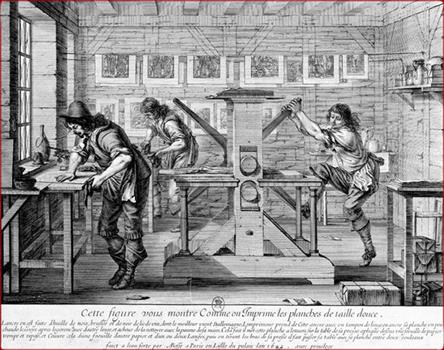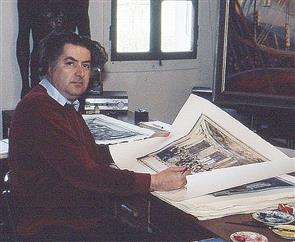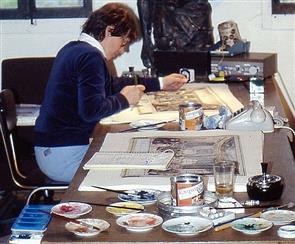
Established in 1946 on the aftermath of World War II in Florence (Italy), this family business grew with the demand mainly from American interior decorators during the construction boom of those years. The need to decorate offices and hotel rooms, not to mention private homes, became a leading market for building year after year a collection of fine art reproductions. The company specialized in reproducing classic XVII and XVIII century engravings, recreating in Paris the copper plates and using the process of hand printing known as”Taille douce” to produce a collection of “estampe”. A lot was due to the extraordinary talent of such engravers as Nourisson, who at the time also worked for the National Bank of France and for many contemporary artists. Where also introduced, besides hand colouring, the use of “pochoir” (or cut-out) colouring and the lithograph printing method on glass plates, a method used since the XIX century for small editions of post cards.
As the business grew, thanks to yearly trips to North America of Harry and Alexandra de Hadeln, a solid address book of clients was built. During the 50s while Alexandra was remaining in New York to take care of the local business, Harry would tour in Grey Hound buses the country, from Boston to San Francisco, and from Los Angeles to Washington. The company was for a time registered in Paris under the name “GLAMOR Srl” (“Gravures, Lithographies, Anciennes et Modernes, Originales ou Reproduites”). In the early 60s it extended its market by importing for the European market reproductions of contemporary American and European artists produced by the American Graphic Society. Their last trip to America was in 1963. Meanwhile it was also marketing engravings and lithographs from Alexandra de Hadeln-Balaceano own works.
On the road to Switzerland
With the rising production costs, the high cost of the Arche drawing paper needed for this type of printing and the growing use of cheaper quadrichrome printing methods using automatic rotative machines, the traditional art of “Taille Douce” or “Estampe” became out of price for decorative items destined to a large market.
Thus from the 70s onward the business declined as clients chose to buy cheaper reproductions and imitations of true engravings printed with rotative printers and a false copper plate edge mark to give the illusion of a genuine engraving. The last catalogue of the company was published in 1971.
The business then concentrated more and more on promoting the work of Alexandra de Hadeln-Balaceano (1915-1977) as well as safegarding Detlev von Hadeln's memory.
In 1971 the business was transferred to Switzerland by Moritz and Erika de Hadeln and established as “de Hadeln & Cie” in Gland. No longer in the printing business, it is marketing the large stock of remaining “Estampe” and lithographs as well as a collection of originals from the early Italian and French company, and foremost concentration on the promotion of Alexandra de Hadeln-Balaceano legacy made of hundreds of oil paintings, drawings, sketches and a collection of sculptures. Her work was entirely photographed and catalogued for the first time in 2008.


In sizes known by printers as the “double colombier” (90x126cm) to miniatures sheets, among the hundreds of subjects reproduced and hand printed from copper plates, always in pairs of two or more pendants, one finds among others the “Antique Flowers Vases” by Nicolas de Poilly (1675-1747), the “Flowers” by Laudons or Seguy, “The Message” , “The Allegories of History, Poetry, Drama and Music” or “The Nest and Garland” by François Boucher (1703-1770), the “Seasons of the Year” by Nicolas Lancret (1690-1743), “Country Scenes” by Antoine Watteau (1684-1721), the “Fable of Birth” by Firmin, “ Grecian Scolls & Cameos” by Cassini, “Roman Arthitecture” and “Views of Rome” by Giovanni P. Pannini (1691-1765), “Views of the Fountains of Versailles” by Jacques Rigaud (1680-1754), the “Ports of France” by Claude J. Vernet (1714-1789), “American Ports” by Amboise L. Garneray (1783-1857), “Views of Lille and Tournai” by Adam F. Van der Muellen (1632-1690), “Dance Scenes” by Adolphe Goupil (1806-1893), “Children's Games” by Charles-G. de St Aubin (1721-1786), “The Happy Family” by Jean H. Fragonard (1732-1806), scenes of horse riding or hunting by CharlesTurner (1773-1857), Johann M. Rugendas (1802-1858) or N. Currier (1813-1888) and J. M. Ives (1824-1895), Carle Vernet (1758-1836) , H. Alken (1785-1851) and W. Hodges (1744-1797), Carel Van Falens (1683-1733), or Pollard, the “Riding School” by Antoine de Pluvinel (1552-1620), the “French Cavalry” by Lange, not to mention scenes of trade and professions. At a latter stage was added to the collection “The Tuilleries of Paris” by A. de Hadeln and “Scenes of Paris” by J. Perrigot, an alias she used for marketing purposes.




"de Hadeln & Cie" today...
“de Hadeln & Cie” was registered from March 20, 1978 until the end of 2012 at the "Registre du commerce du Canton de Vaud" under the No. CH-550-0177171-9. Due to the activities of Moritz and Erika de Hadeln in the field of cinema (cf. “de Hadeln & Partners, film consulting”), the activity of “de Hadeln & Cie” has however been limited.



de Hadeln & Cie
Fine Art Publishers
established since 1946





